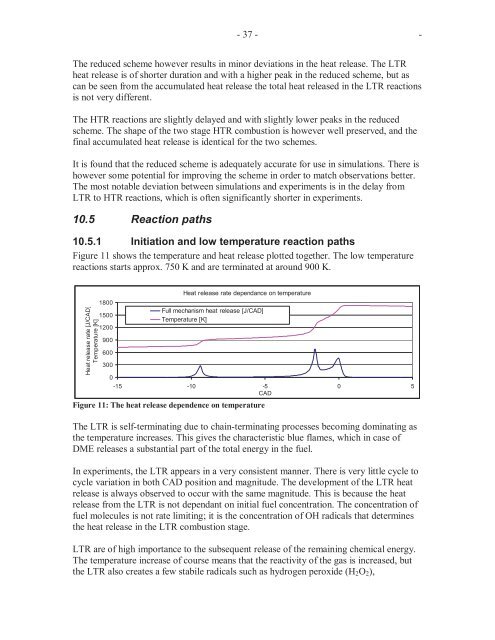Troels Dyhr Pedersen.indd - Solid Mechanics
Troels Dyhr Pedersen.indd - Solid Mechanics
Troels Dyhr Pedersen.indd - Solid Mechanics
Create successful ePaper yourself
Turn your PDF publications into a flip-book with our unique Google optimized e-Paper software.
- 37 - -<br />
The reduced scheme however results in minor deviations in the heat release. The LTR<br />
heat release is of shorter duration and with a higher peak in the reduced scheme, but as<br />
can be seen from the accumulated heat release the total heat released in the LTR reactions<br />
is not very different.<br />
The HTR reactions are slightly delayed and with slightly lower peaks in the reduced<br />
scheme. The shape of the two stage HTR combustion is however well preserved, and the<br />
final accumulated heat release is identical for the two schemes.<br />
It is found that the reduced scheme is adequately accurate for use in simulations. There is<br />
however some potential for improving the scheme in order to match observations better.<br />
The most notable deviation between simulations and experiments is in the delay from<br />
LTR to HTR reactions, which is often significantly shorter in experiments.<br />
10.5 Reaction paths<br />
10.5.1 Initiation and low temperature reaction paths<br />
Figure 11 shows the temperature and heat release plotted together. The low temperature<br />
reactions starts approx. 750 K and are terminated at around 900 K.<br />
Heat release rate [J/CAD]<br />
Temperature [K]<br />
1800<br />
1500<br />
1200<br />
900<br />
600<br />
300<br />
0<br />
Heat release rate dependance on temperature<br />
Full mechanism heat release [J/CAD]<br />
Temperature [K]<br />
-15 -10 -5 0 5<br />
CAD<br />
Figure 11: The heat release dependence on temperature<br />
The LTR is self-terminating due to chain-terminating processes becoming dominating as<br />
the temperature increases. This gives the characteristic blue flames, which in case of<br />
DME releases a substantial part of the total energy in the fuel.<br />
In experiments, the LTR appears in a very consistent manner. There is very little cycle to<br />
cycle variation in both CAD position and magnitude. The development of the LTR heat<br />
release is always observed to occur with the same magnitude. This is because the heat<br />
release from the LTR is not dependant on initial fuel concentration. The concentration of<br />
fuel molecules is not rate limiting; it is the concentration of OH radicals that determines<br />
the heat release in the LTR combustion stage.<br />
LTR are of high importance to the subsequent release of the remaining chemical energy.<br />
The temperature increase of course means that the reactivity of the gas is increased, but<br />
the LTR also creates a few stabile radicals such as hydrogen peroxide (H2O2),

















